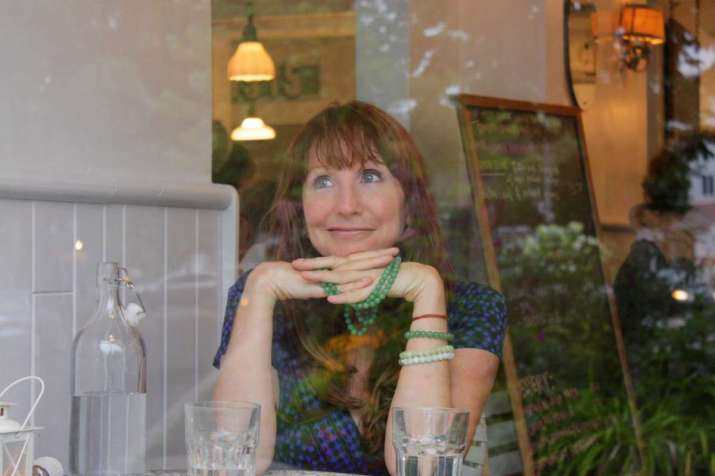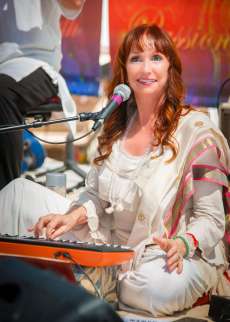Buddhist Kirtan: Interview with American Mantra Musician Lee Mirabai Harrington, Part One
By Nina Müller
Buddhistdoor Global
| 2019-06-17 |  Lee Mirabai Harrington at Garden Cafe in Woodstock, New York. Photo by Amber Roniger. From leeharringtonmantramusic.com
Lee Mirabai Harrington at Garden Cafe in Woodstock, New York. Photo by Amber Roniger. From leeharringtonmantramusic.comLee Marabai Harrington offers a unique form of “Buddhist mantra kirtan,” combining the metta and wisdom energies of Buddhist mantras with the heart-opening euphoria of the devotional Bhakti tradition. Harrington’s first album of mantra music, Beyond the Beyond: A Mantra Music Experience, was released to critical acclaim in 2016. Her oeuvre includes singing mantras for His Holiness the Karmapa at Madison Square Garden and for Amma at Amritapuri ashram in India. This month she sat down with Buddhistdoor Global and discussed her wish to serve others through the joyful and healing power of mantra singing.
Buddhistdoor Global: How did you come to Vajrayana Buddhism and what school do you belong to?
Lee Mirabai Harrington: The short answer is that I was probably Buddhist in many previous lifetimes. I’m grateful that I found the Dharma again in this lifetime and that I was able to meet my precious guru His Holiness the 17th Karmapa, Ogyen Trinley Dorje. I’ve also studied with His Holiness the Dalai Lama, Tai Situ Rinpoche, Dzogchen Ponlop Rinpoche, Khandro Rinpoche, Mingyur Rinpoche, and the great Western Buddhist teachers Robert A. F. Thurman, John Daido Loori Roshi, Pema Chodron, and Sharon Saltzberg. And of course Khenpo Karthar Rinpoche, who presides over Karma Triyana Dharmachakra Monastery, where I practice. I also study Tibetan medical mantras with Dr. Nida Chenagtsang.
BDG: What is Buddhist mantra kirtan?
LMH: This is actually a tricky question because Buddhist mantra kirtan is a term I made up myself to loosely describe what I do. It’s actually not a genre that exists—as far I know I am the only Buddhist on the American kirtan circuit who leads kirtans specializing in Buddhist mantras. In a nutshell, I combine elements of traditional kirtan (Hindu devotional call-and-response chanting) with the recitation of Buddhist mantras.
 Lee Mirabai Harrington. Photo by Tara Sproc. From leeharringtonmantramusic.com
Lee Mirabai Harrington. Photo by Tara Sproc. From leeharringtonmantramusic.comTypically in Vajrayana practices, as your readers might be aware, Buddhist mantras are recited within the context of a longer, larger puja or sadhana, and there are a series of steps that are taken before the mantras are recited, such as invoking deities (yidams), making offerings, and so on. There are also visualization practices that one engages in during mantra recitation. So I bring elements of my own Vajrayana practice into my kirtans and workshops (with my teacher’s permission, of course) and combine it with the traditional Hindu method of call-and-response singing.
I explain what I am doing to my participants and I do my best to make it clear that what I offer is not a substitute for a Buddhist sadhana. My hope is that my kirtans will inspire people to learn more about the Buddhadharma, mantrayana (liberation through sound) and the sadhanas, and to take the empowerments, and so on.
BDG: What are some of the inspiring effects of your Buddhist mantra kirtans?
LMH: When we chant—especially when we chant with focus, confidence, and devotion—subtle shifts are taking places at so many levels. Shifts in consciousness, in energetic balance, in mood, in vibration. First of all, there is a sound-healing aspect in kirtan that is taking place—we are singing sacred syllables in specific patterns and those patterns are like key codes, if you will, that are unlocking potential that is already within us. We all have within us, for example, the capacity for true compassion. Chanting the syllables Om Mani Padme Hum awakens that compassion. To continue with the keypad analogy: when we chant, the tongue hits certain meridian points on the roof of the mouth, so again a code is being “entered” into our system. Our physical system responds to the mantra, as well as the energetic systems, etc.
 Lee Mirabai Harrington at Bhaktifes. Photo by Joyful Images. From leeharringtonmantramusic.com
Lee Mirabai Harrington at Bhaktifes. Photo by Joyful Images. From leeharringtonmantramusic.comThere is also a profound devotional aspect in kirtan. In yogic terms, Bhakti Yoga is the yoga of devotion. To me, the Buddhist mantras I sing are very devotional. There’s my own private devotion to my guru, first of all. We’re also singing praises to Tara (an aspect of the divine feminine), to Avalokiteshvara (the bodhisattva of compassion), to Prajnaparamita (who represents perfect wisdom).
If there are people in the room who are uncomfortable with or unfamiliar with “singing to funny-colored Buddhist deities,” [laughter] I explain that we are not only expressing devotion to these deities—or aspects, or emanations: we are praising those qualities within ourselves to help them awaken. But the point is, in call and response, when we call (meaning, when we sing out the mantra), the gods and goddesses respond. The mantras respond (call and response typically refers to the leader singing and the audience responding, but I like to take the analogy further). When we chant the Medicine Buddha mantra, for instance, we are going to feel an energy of great healing; of balance, purification. That is the nature of the Medicine Buddha and his mantra. The mantra is calibrated to remove sickness, to heal. That is his response. That is his vow—to free all beings from sickness—and chanting the mantra awakens that vow.
BDG: How do North American audiences respond to your events?
LMH: Everyone loves it. Everyone tells me they feel transformed. At the very least, people experience a sense of peace and open-heartedness. A lot of Westerners who haven’t had any experience with, or exposure to, Buddhist teachings and/or Buddhist practices have this mistaken notion that Buddhism is a depressing path. Like, we’re all about suffering and emptiness.* But I personally have found great joy, peace, and freedom on the Buddhist path and I feel that this sense of joy and peace is transmitted at my kirtans and workshops.
Another misconception people might have when they see the words “Buddhist chanting” in an event title is that some people might think we are going to be doing very deep-toned, monotoned throat singing like the Gyoto monks. The Gyoto monks are great, but that is not what I do. At my events, we are singing these mantras kirtan-style, with beautiful melodies and lots of musical instruments: harmonium, esraj, bass, tabla or dejembe. Sometimes an electric guitar or violin or cello. Flutes. I know many wonderful kirtan musicians who bring a profound level of musicality to my events. Before my events I always remind my bandmates that their music is medicine, just as the mantras are medicine. And participants really respond to that.
I’ve led kirtans at Korean Buddhist temples, Tibetan Buddhist monasteries, small Dharma centers—places where there are serious practitioners who do a lot of chanting themselves. I get the same reaction each time. People feel blissful, totally tapped into their bodhicitta. There’s something about singing the mantras and riding on the gandharva-melodies that carries us straight into the bliss realm. And it’s not me that’s doing this. It’s the mantras. The yidams. My guru. The Three Jewels. And yes, I recognize that, as proper Buddhists, we are not supposed to get attached to these joyful states [laughter]. But it feels very refreshing to tap into something this pure via mantra. Again, I hope it inspires people to take empowerments and go deeper into the practice.
*LMH: As an aside: long ago, one of my teachers—Bob Thurman, a pre-eminent Buddhist scholar and translator—pointed out that the more correct translation of the First Noble Truth is “In life, there is suffering.” As opposed to the more common “life is suffering.” This new view was particularly liberating for me as a young student of Buddhism. We can all acknowledge that there is indeed suffering in this world. The Buddhadharma offers us ways out of suffering.
Lee Mirabai Harrington is holding an upcoming retreat, “Reawakening the Compassionate Heart,” which will be hosted at Sivananda Bahamas from 28–30 June 2019. To find out more please go to the retreat webpage.
See more
Lee Mirabai Harrington
Related news from Buddhistdoor Global
Japanese Monastics Share Ancient Buddhist Sutras Through Modern Music
Kalmyk Musical Performance of the Buddha’s Life Presented in Tuva and Buryatia
Nepal’s Rock Star Buddhist Nun Touches Hearts and Changes Lives
Related features from Buddhistdoor Global
Harmonic Presence: Qualities of Silence, Listening, and Sound with David Hykes
Modern-day Ghandarva – Hans Schumacher’s Journey Through Music
Tam Po Shek and Wing Chi Ip: Refreshing the Soul and the Senses by Playing the Flute and Drinking Tea
The Bodhi Group: Singing in Praise of the Buddha
More from Coastline Meditations by Nina Müller


















